2. 天津职业大学生物与环境工程学院, 天津 300410;
3. 天津市化工安全与装备技术重点实验室, 天津 300350
2. School of Biological and Environment Engineering, Tianjin Vocational Institute, Tianjin 300410, China;
3. Tianjin Key Laboratory of Chemical Process Safety and Equipment Technology, Tianjin 300350, China
重力热管(TPCT)是一种高效的换热器,它利用工质在管内的相变传热来实现热量从热源到冷源的传递。由于其具有导热性能高、自身结构简单和使用操作方便等诸多优点,现已在核反应过程中的冷却换热[1, 2]、地热能源的利用[3, 4]、太阳能的使用[5, 6]和LED灯的散热[7]等换热领域得到了较为广泛的应用。
能源紧张和环境问题的日趋彰显,对换热设备的强化传热提出了更高的要求。因此,研究人员围绕TPCT的强化传热方式进行了许多的探索。到目前为止,相应的强化传热方法主要集中在改进热管内部结构[8-10]、表面修饰[11-14]和使用新工质[15-26]等3个方面。
与改进热管内部结构和表面修饰相比,使用新工质可以减少设备结构的复杂性和加工成本。目前的新工质主要包括混合流体[15, 16]、全氟介质[17, 18]、自润湿流体[19, 20]和纳米流体[21-24]。其中,纳米流体由于其优异的热物理性能而得到了更多的关注。一些实验结果表明,在使用纳米流体后,TPCT的热性能得到了明显地提升。Choi等[23]使用了纤维素纳米流体,研究了该新工质对TPCT传热性能的影响。他们发现,使用该新工质后,TPCT的临界热流密度提升了14.3%,沸腾传热系数提高了71.74%。Xu等[24]考察了单纳米流体和杂化纳米流体在TPCT中的传热性能,并与去离子水进行了比较。结果表明,纳米流体最大可将TPCT的热阻降低26.8%。
但也有一些研究指出,在使用某些纳米流体后,TPCT的传热性能发生了下降[25, 26]。Khandekar等[25]的研究表明,与纯水相比,3种水基纳米流体均增加了TPCT的总热阻。Chen等[26]考察了水基SiO2功能化纳米流体TPCT的传热特性。结果表明,使用该新工质后,蒸发段的传热系数与热流密度均发生了减小。此外,纳米颗粒或纳米流体的制作工艺复杂、成本高,且其稳定性难以满足长时间连续使用,这些都限制了纳米流体的工业应用。
流化床换热节能技术(FBHFPT)可应用于换热设备[27, 28],形成高效的流化床换热装置。惰性固体颗粒在流化后可使流动和传热边界层得到减薄甚至破坏,降低了传热过程的阻力,进而实现传热过程的强化。同时,换热壁面受到颗粒的碰撞后,还能有效防止溶液在近壁面处出现过饱和,使结垢诱导期得到较大的延长,从而实现在线防垢的作用。此外,传热过程的强化还能够使管壁温度下降,有利于减少对管壁的腐蚀。该技术已经引起了研究者广泛的关注[29-32],已在工业上具有了一定的应用。
因此,将FBHFPT应用于TPCT,开发出三相(V/L/S)闭式重力热管(THPCT),促进了TPCT传热强化方法的发展。Jiang等[33-38]以水作为工质,构建了THPCT,并初步对其传热性能进行了实验研究。他们发现,在不同的操作条件下,THPCT的传热增强效果均比较理想。但THPCT的实验研究还处于起步阶段,到目前为止,关于THPCT的热性能随倾角变化的规律,还没有文献进行相关的报道。而加入的惰性固体颗粒存在于液池中,热管倾角的变化又会影响热管内部相的分布和颗粒的流化,进而改变传热效果。Gou[39]和Kim[40]考察了倾角对TPCT传热性能的影响。结果表明,倾角对冷凝传热系数的影响大于对沸腾传热系数的影响;在倾角为60°时,重力热管具有较好的传热性能。因此,本研究拟开发倾角可变的THPCT,实验研究其传热性能随倾角变化的规律。所用的热管壳体材料为紫铜,工作流体为水,固相工质分别为碳化硅(SiC)、聚甲醛(POM)和玻璃珠颗粒。
1 实验 1.1 实验装置及流程本研究开发并组装了可变倾角的THPCT,如图 1和图 2所示。实验装置包括3部分,分别是数据采集系统、真空泵和热管。
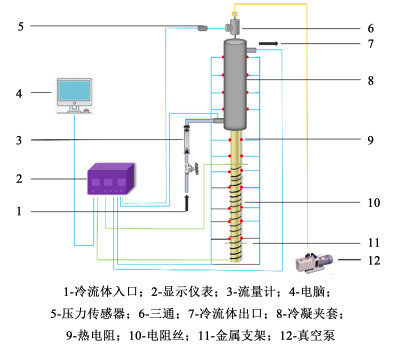
|
| 图 1 实验装置图 Fig.1 Diagram of the experimental apparatus |
| |
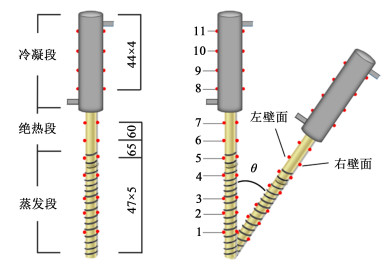
|
| 图 2 可变倾角的重力热管 Fig.2 THPCT with variable inclination angle |
| |
实验所用的热管为长600 mm,管径Ф22 mm×1.5 mm的紫铜管,可分成3个部分,分别是冷凝段(220 mm)、绝热段(140 mm)和蒸发段(240 mm)。
实验所用的加热装置是由镍铬电阻丝制造的加热带,蒸发段由该加热带进行加热。冷凝段由冷凝夹套所包裹,使用冷却水移走冷凝潜热。为测量热管内部的真空度和操作压力,在热管冷凝段的上端安装了真空压力传感器。冷却水的体积流量保持在20 L·h-1,其值由转子流量计来测量,冷却水的进口和出口温度均利用热电阻温度计测量。
为对热管外壁温度进行测量,本研究在热管左右两侧各选取了11个对称的测温点,并安装了热电阻温度计,同时进行了引线电阻补偿。其中,蒸发段5对,绝热段2对,冷凝段4对。为使热量损失降到最低,还在热管外壁面处包裹了保温棉。利用真空泵把热管内的空气抽出,并达到指定真空度(95 kPa)。热管稳定运行时的工作温度为19~76 ℃,压力范围(表压)为-93.6~-79.20 kPa。利用AI-501 MF数字仪表来显示温度及压力,并采用“组态王”软件将实验数据自动采集并保存到电脑中。图 1列出了实验所用仪表的相关型号及规格。
首先将一定量的水和固体颗粒加入到闭式重力热管中。然后打开真空泵,待热管内部压力达到指定真空度后,切断热管与真空系统的连接,使其处于真空状态。打开冷却水,调节转子流量计使冷却水流量保持在20 L·h-1。打开加热装置,将加热功率调节到指定值。待热管稳定运行后(即20 min内所有热电阻温度计的温度变化均小于1 ℃),即可采集压力和温度数据。改变加热功率、倾角和颗粒种类等参数,重复上述实验。每个条件重复3次,以检查数据的重复性。
| 仪表 | 型号 | 量程 | 精度 | 误差 |
| 转子流量计 | LZB-6 | 6~60 L·h-1 | 4.00(%FS) | (±2.4) L·h-1 |
| 热电阻温度计 | Pt100 | -100~300 ℃ | A | [±(0.15 ℃+0.002|t|)]℃ |
| 压力传感器 | M93420GP | 0~100 kPa | 0.25 (%FS) | (±0.25) kPa |
| 注:|t|=温度的绝对值。 | ||||
实验中选用水作为液体工质,添加的惰性固体颗粒分别为碳化硅(SiC)、聚甲醛(POM)和玻璃珠颗粒。3种颗粒都具有较好的耐磨性能及腐蚀性能,其中,碳化硅颗粒密度大,导热系数高,粒径小;聚甲醛颗粒粒径较大、密度较小、导热系数低;玻璃珠粒径较小,密度和导热系数适中。固体颗粒的相关物性如表 2所示。
| 粒径/mm | 导热系数/(W·m-1·℃-1) | 密度/(kg·m-3) | 沉降速度/(m·s-1) | |
| 碳化硅 | 0.18 | 83.6 | 3 180 | 0.026 8 |
| 聚甲醛 | 2.00 | 0.3 | 1 390 | 0.159 2 |
| 玻璃珠 | 0.18 | 1.1 | 2 500 | 0.020 3 |
| 注:不同颗粒的沉降速度是在常压条件和20 ℃的水中测定。 | ||||
本实验研究了颗粒类型、倾角和加热功率对THPCT传热性能的影响。实验中使用的充液率(管内液体的体积与热管的总容积之比)和固含率(管内固体颗粒的堆体积与液体的体积之比)分别为20%和10%。
1.3 数据处理和误差分析当传热达到稳态时,利用冷却水从热管内吸收的热量,来计算热管的传热速率,如式(1)所示。
| $ Q_{\mathrm{c}}=\rho_{\mathrm{w}} V_{\mathrm{w}} c_{\mathrm{pw}}\left(t_{\mathrm{o}}-t_{\mathrm{i}}\right) $ | (1) |
式(1)中:ρw为水的密度;Vw为水的体积流量;cpw为水的比热容;ti和to分别为水的进、出口温度;Qc为传热速率。
采用总热阻R、蒸发段热阻Re和冷凝段热阻Rc来评估热管的热性能,如式(2)、(3)和(4)所示。
| $ R=\frac{T_{\mathrm{ei}}-T_{\mathrm{ci}}}{Q_{\mathrm{c}}} $ | (2) |
| $ R_{\mathrm{e}}=\frac{T_{\mathrm{ei}}-T_{\mathrm{s}}}{Q_{\mathrm{c}}} $ | (3) |
| $ R_{\mathrm{c}}=\frac{T_{\mathrm{s}}-T_{\mathrm{ci}}}{Q_{\mathrm{c}}} $ | (4) |
式(2)~(4)中:Tei和Tci分别为蒸发段和冷凝段的平均内壁温,Ts为绝热段的平均外壁温,可作为液相工质的饱和温度。可利用一维圆筒壁在稳态时的传热速率方程和平均外壁温来计算平均内壁温,如式(5)和(6)所示。
| $ \int\limits_{T_{\mathrm{ei}}}^{T_{\mathrm{eo}}} \lambda_0(1+b t) \mathrm{d} t=\frac{Q_{\mathrm{c}} \ln \left(d_{\mathrm{o}} / d_{\mathrm{i}}\right)}{2 {\rm{\mathsf{π}}} L_{\mathrm{e}}} $ | (5) |
| $ \int\limits_{T_{\mathrm{si}}}^{T_{\mathrm{co}}} \lambda_0(1+b t) \mathrm{d} t=\frac{Q_{\mathrm{c}} \ln \left(d_{\mathrm{i}} / d_{\mathrm{o}}\right)}{2 {\rm{\mathsf{π}}} L_{\mathrm{c}}} $ | (6) |
式(5)~(6)中:do与Le分别为热管的外径和内径;Lc与Le分别为冷凝段长度与蒸发段长度。λ0=383.79 W·m-1·℃-1,为0 ℃时铜的导热系数;b=-1.2×10-4 ℃-1,为铜的温度系数。
使用对流传热系数来评估蒸发段及冷凝段2部分的传热性能。计算分别如式(7)和(8)所示。
| $ h_{\mathrm{e}}=\frac{Q_{\mathrm{e}}}{{\rm{\mathsf{π}}} d_{\mathrm{i}} L_{\mathrm{e}}\left(T_{\mathrm{ei}}-T_{\mathrm{s}}\right)} $ | (7) |
| $ h_{\mathrm{c}}=\frac{Q_{\mathrm{c}}}{{\rm{\mathsf{π}}} d_{\mathrm{i}} L_{\mathrm{c}}\left(T_{\mathrm{s}}-T_{\mathrm{ci}}\right)} $ | (8) |
分别采用总热阻减少率Er和增强因子E来描述THPCT的传热增强效果,如式(9)、(10)和(11)所示。
| $ E_{\mathrm{r}}=\frac{R_{\mathrm{t}}-R_{\mathrm{th}}}{R_{\mathrm{t}}} \times 100 \% $ | (9) |
| $ E_{\mathrm{e}}=\frac{h_{\mathrm{eth}}-h_{\mathrm{et}}}{h_{\mathrm{et}}} \times 100 \% $ | (10) |
| $ E_{\mathrm{c}}=\frac{h_{\mathrm{cth}}-h_{\mathrm{ct}}}{h_{\mathrm{ct}}} \times 100 \% $ | (11) |
式(9)~(11)中:Rth和Rt分别为THPCT和TPCT的总热阻;heth和het分别为THPCT和TPCT的蒸发段对流传热系数;hcth和hct分别为THPCT和TPCT的冷凝段对流传热系数。
本研究中计算了传热速率、蒸发段和冷凝段对流传热系数以及总热阻,并进行了不确定度分析,参考式(12)~(15)。
| $ \frac{u\left(Q_{\mathrm{c}}\right)}{Q_{\mathrm{c}}}=\sqrt{\left[\frac{u\left(V_{\mathrm{c}}\right)}{V_{\mathrm{c}}}\right]^2+\frac{u^2\left(t_{\mathrm{i}}\right)+u^2\left(t_{\mathrm{o}}\right)}{\left(t_{\mathrm{i}}-t_{\mathrm{o}}\right)^2}} $ | (12) |
| $ \frac{u\left(h_{\mathrm{e}}\right)}{h_{\mathrm{e}}}=\sqrt{\left[\frac{u\left(Q_{\mathrm{e}}\right)}{Q_{\mathrm{c}}}\right]^2+\frac{u^2\left(T_{\mathrm{ei}}\right)+u^2\left(T_{\mathrm{s}}\right)}{\left(T_{\mathrm{ei}}-T_{\mathrm{s}}\right)^2}} $ | (13) |
| $ \frac{u\left(h_{\mathrm{c}}\right)}{h_{\mathrm{c}}}=\sqrt{\left[\frac{u\left(Q_{\mathrm{c}}\right)}{Q_{\mathrm{c}}}\right]^2+\frac{u^2\left(T_{\mathrm{ci}}\right)+u^2\left(T_{\mathrm{s}}\right)}{\left(T_{\mathrm{s}}-T_{\mathrm{ci}}\right)^2}} $ | (14) |
| $\frac{u(R)}{R}=\sqrt{\left[\frac{u\left(Q_{\mathrm{c}}\right)}{Q_{\mathrm{c}}}\right]^2+\frac{u^2\left(T_{\mathrm{ei}}\right)+u^2\left(T_{\mathrm{ci}}\right)}{\left(T_{\mathrm{ei}}-T_{\mathrm{ci}}\right)^2}} $ | (15) |
本实验中,传热速率、蒸发段和冷凝段对流传热系数以及总热阻的不确定度分别为6.79%、7.12%、6.82%和6.80%。
2 结果与讨论 2.1 不同倾角下THPCT的强化传热性能图 3所示为倾角和加热功率对THPCT总热阻减少率的影响。由图 3可知,总热阻减少率基本上随着倾角和加热功率的增加而波动变化。
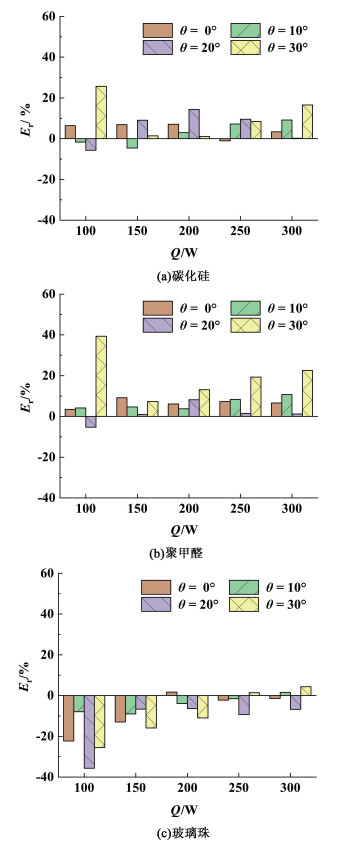
|
| 图 3 倾角对总热阻减少率的影响 Fig.3 Effect of inclination angle on the reduction rate of the overall thermal resistance |
| |
大多数情况下,SiC和聚甲醛颗粒都能够降低热管的总热阻,使传热得到强化,而玻璃珠颗粒却使总热阻升高,传热发生了恶化。加入碳化硅和聚甲醛颗粒时,最大的总热阻减少率分别为25.7%和39.4%,均在θ=30°和Q=100 W时获得。
一方面,热管内的固体颗粒主要分布在液池中。液池受到沸腾汽泡的扰动,湍动程度加剧,导致了颗粒的流化。而在流化后,颗粒会以剪切和碰撞的方式作用于加热壁面,使流动与传热边界层被破坏,使传热热阻减小。同时,颗粒直接和蒸发段的加热壁面发生碰撞,还可以使汽化核心进一步增加,使汽泡脱离壁面时半径减小,加快汽泡的脱离,从而强化沸腾传热。此外,大汽泡在流化颗粒的作用下,更易变为小汽泡。而从液池中逃逸出的小汽泡可以减少液膜夹带,可以使附着在壁面上的液膜变薄,减小传热阻力。另一方面,颗粒加入后,颗粒床层也会增加流体的流动阻力,对液池中汽泡的运动有较大的阻碍,使沸腾传热过程的传热速率降低。同时,在离开液池时,会出现较大的汽泡,增加液膜的夹带量,使冷凝段传热阻力增加。
综合对比实验中的3种颗粒,玻璃珠颗粒粒径小,密度较低,沉降速度小,流化效果较好,对加热壁面和边界层的作用更强,因此可以有效地强化蒸发段的传热,如图 4(c)所示。而碳化硅和聚甲醛颗粒由于密度或尺寸较大,沉降速度高于玻璃珠颗粒,流化效果较差,因此在加入碳化硅颗粒后,蒸发段的传热增强效果并不如玻璃珠。同时,沸腾传热由于汽泡从液池逸出时受到颗粒床层的阻碍而被抑制,因此,使得碳化硅和聚甲醛颗粒的加入在一些情况下恶化了蒸发段的传热,如图 4(a)和图 4(b)所示。
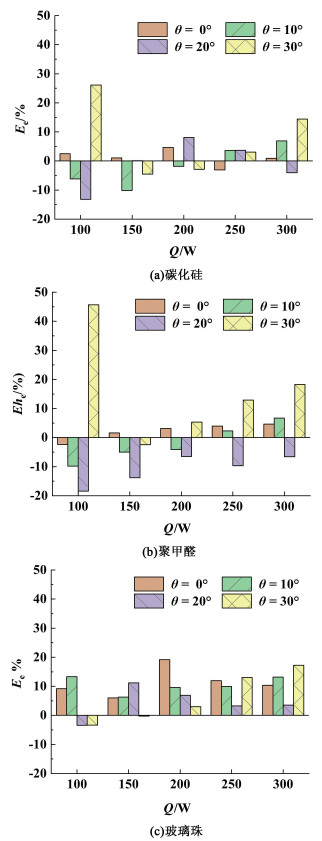
|
| 图 4 倾角对蒸发段增强因子的影响 Fig.4 Effect of inclination angle on the enhancement factor of the evaporation section |
| |
然而,重力热管的传热效果取决于蒸发段与冷凝段两部分。流化程度较好的玻璃珠颗粒,其床层对汽泡在液池中上升和逸出所形成的阻力较大;同时,由于其粒径较小和密度较低,对蒸发段液池中上升汽泡的撞击力和破坏程度也较小,不利于将大汽泡破碎成小汽泡,因此导致了较为严重的液膜夹带,使附着在冷凝段表面的液膜进一步变厚,使冷凝段的传热阻力增加,导致传热发生了恶化,如图 5(c)所示。而碳化硅和聚甲醛颗粒由于密度或尺寸较大,有利于将大汽泡破碎成小汽泡,减轻液膜夹带,强化冷凝段的传热,如图 5(a)和图 5(b)所示。因此,在蒸发段和冷凝段的共同作用下,SiC和POM颗粒的加入基本上均可以降低总热阻,强化传热,而玻璃珠颗粒的加入基本上增加了总热阻,使传热发生了恶化。
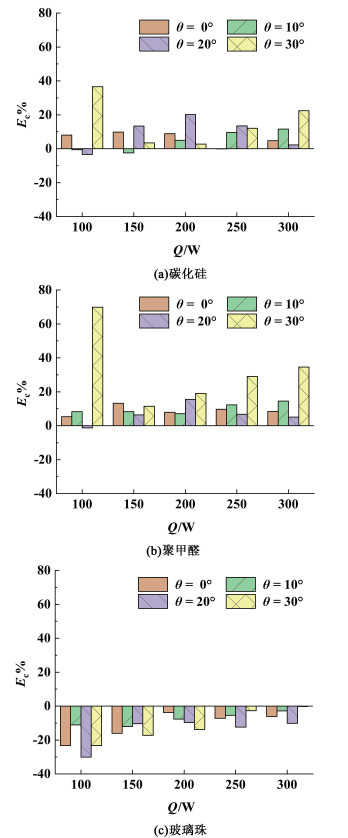
|
| 图 5 倾角对冷凝段增强因子的影响 Fig.5 Effect of inclination angle on the enhancement factor of the condensation section |
| |
图 6描述了加热功率和倾角对总热阻的影响。总的来说,TPCT和THPCT的总热阻在4个倾角下均随着加入功率的增加而降低,但其程度不断变小。在同一加热功率条件下,总热阻基本上随着倾角的增加而波动变化,最大值一般出现在倾角为30°时;但加热功率增加后,4个倾角所对应的总热阻之间的差异不断变小。

|
| 图 6 倾角对闭式重力热管总热阻的影响 Fig.6 Effect of inclination angle on the overall thermal resistance of the THPCT |
| |
总热阻是蒸发段和冷凝段传热阻力的整体反映。图 7和图 8所示分别为蒸发段对流传热系数和冷凝段对流传热系数随着倾角的变化趋势。
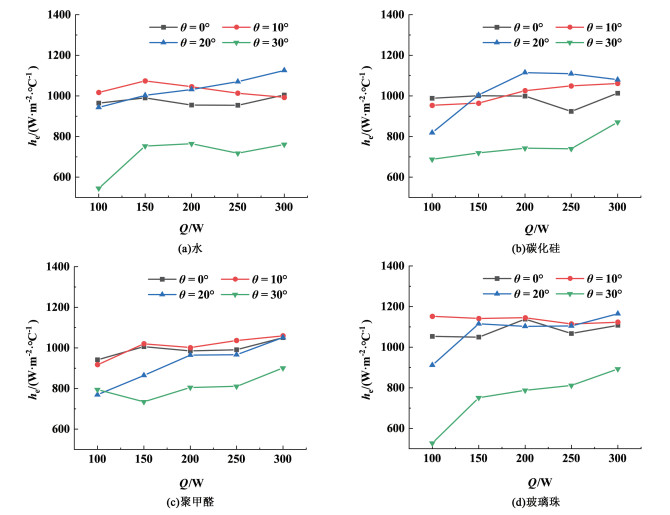
|
| 图 7 倾角对蒸发段对流传热系数的影响 Fig.7 Effect of inclination angle on the convective heat transfer coefficient of the evaporation section |
| |
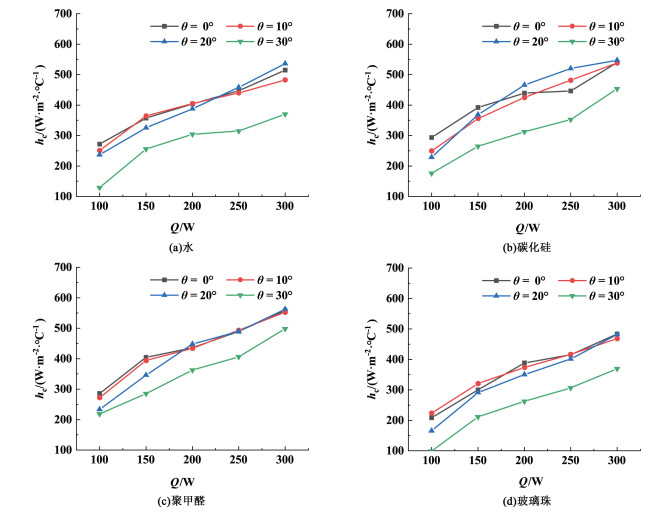
|
| 图 8 倾角对冷凝段对流传热系数的影响 Fig.8 Effect of inclination angle on the convective heat transfer coefficient of the condensation section |
| |
如图 7所示,蒸发段对流传热系数一般随着加热功率和倾角的增加而波动。一方面,加热功率增大后,蒸发段的壁面过热度会增加,汽化核心增加,有利于液池的泡核沸腾。液池内汽泡的剧烈运动加剧了液池的湍流,有利于颗粒的流化,增强了相间作用,亦有利于强化传热。另一方面,在加热功率提高后,汽泡数量增多,导致汽膜于加热壁面生成聚集,进而增大了传热阻力。同时,颗粒的流化也一定程度上阻碍了汽泡从液池的逸出,使沸腾传热过程阻力增加。受以上两方面因素的影响,加热功率的增加导致蒸发段对流传热系数随之波动变化。
在重力作用下,随着倾角的增加,汽泡在液池中上升的浮升力减小,不利于汽泡从液池中逸出,进而抑制了汽泡脱离壁面和泡核沸腾。同时,汽泡倾向于附着在蒸发段左侧加热壁面(图 2)上,不易脱离,形成汽膜,从而增大了对流传热阻力。另一方面,随着倾角的增加,蒸发段与冷凝段的高度差缩小,有利于蒸汽从蒸发段液池表面流向冷凝段,促进汽泡从液池中逸出,促进沸腾传热。同时,倾角增加降低了蒸发段液池液位的竖直高度,汽泡更容易从蒸发段右侧的加热壁面(图 2)脱离,进而促进沸腾传热。由于以上因素的影响,在倾角增大时,蒸发段的对流换热系数随之波动变化。
加热功率增大使得冷凝段的对流传热系数增加,而倾角的增大却使其波动变化,如图 8所示。此外,在不同的加热功率下,基本上倾角为30°时冷凝段的对流传热系数最小。
加热功率增加,单位时间内产生的蒸汽量增大。从液池到冷凝段的蒸汽流速增加,冷凝段的液膜受到更强的扰动,液膜内部湍动程度增大,从而减小了冷凝段的传热阻力,强化了冷凝段的传热。
倾角的增大减小了冷凝段液膜回流的驱动力,液膜回流速率变小,使附着在冷凝段壁面上的液膜变厚,导致冷凝段传热阻力增大。另一方面,如前所述,蒸发段与冷凝段的高度差随倾角的增大而减小,因此降低了蒸汽从液池表面到冷凝段的流动阻力,促进了蒸汽的流动,增强了对液膜的扰动,使冷凝传热阻力减小。由于以上因素的影响,在倾角增大时,冷凝段的对流传热系数随之波动变化。图 9所示为闭式重力热管内壁温的轴向分布,壁温随着倾角的增加而波动,进一步反映了倾角对对流传热的影响。
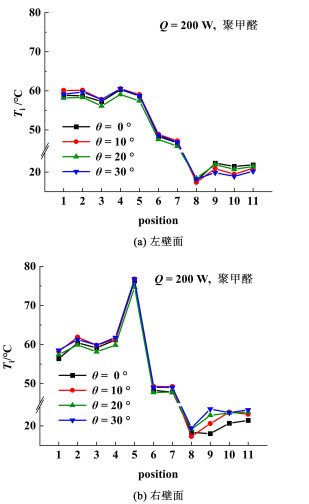
|
| 图 9 倾角对THPCT内壁温的影响 Fig.9 Effect of inclination angle on the inner wall temperature of THPCT |
| |
图 10所示为倾角和加热功率对冷凝段与蒸发段热阻比值的影响。由图 10可知,冷凝段的热阻明显高于蒸发段。因此,由总热阻所反映的传热性能变化趋势与冷凝段对流换热系数所反映的趋势相似,如图 6和图 8所示。

|
| 图 10 冷凝段与蒸发段的热阻比率 Fig.10 Ratio of the thermal resistance of the evaporation section to that of the condensation section |
| |
在加热功率增大时,热阻比率在不同倾角下随之减小,但减小的程度不断下降。在一定的加热功率下,热阻比率一般随倾角的增加而波动,但不同倾角之间热阻比率的差异随加热功率的增大而减小。碳化硅和聚甲醛颗粒的加入降低了冷凝段与蒸发段的热阻比率,而玻璃珠颗粒的加入提高了热阻比率。结合图 7、图 8和图 10可知,加热功率和颗粒类型对冷凝段传热的影响更为显著。
图 11为总热阻的三维等高线图。图 11中描述了倾角、加热功率和颗粒类型对总热阻影响的变化规律,有助于确定三相闭式重力热管的最适宜工艺参数范围,指导工业实践。
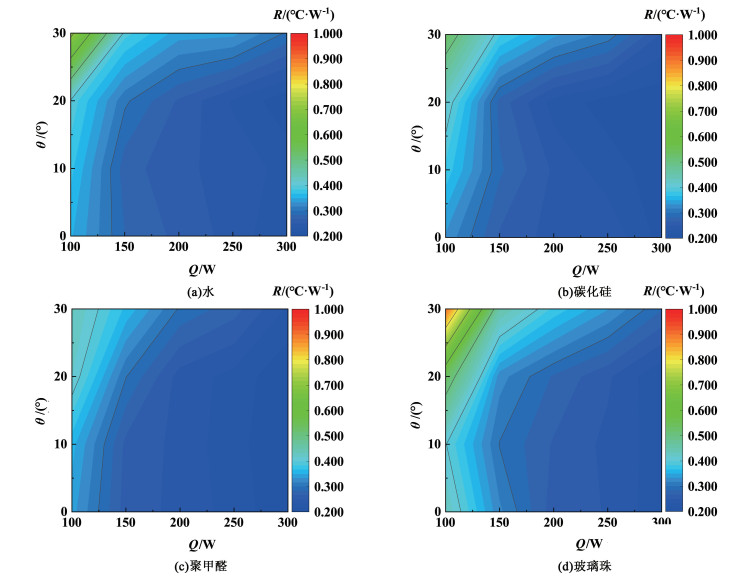
|
| 图 11 总热阻随操作参数变化的三维等高线图 Fig.11 3D contour map of the overall thermal resistance varying with operating parameters |
| |
在不同的颗粒类型和加热功率条件下,实验探究了倾角对铜/水THPCT传热性能的影响,并得到了以下结论。
(1) 在不同的倾角下,SiC和POM颗粒均能明显提高重力热管的传热性能,其总热阻减少率最大分别为25.7%和39.4%;玻璃珠颗粒恶化了重力热管的传热。
(2) TPCT和THPCT的总热阻均随倾角的增加而波动。加热功率的增加导致总热阻减小,但程度不断下降。
(3) 在倾角增大时,蒸发段和冷凝段的对流传热系数均随之波动变化。加热功率对冷凝段传热过程的影响比蒸发段的更为显著。在大多数情况下,碳化硅或聚甲醛颗粒可以强化蒸发段和冷凝段的传热;玻璃珠颗粒可以较好地强化蒸发段的传热,但基本上恶化了冷凝段的传热。
(4) 冷凝段的热阻明显高于蒸发段,对总热阻产生了更大的影响。在加热功率增大时,蒸发段和冷凝段的热阻比率在4个倾角下均随之不断减小,但程度不断降低。热阻比率一般随倾角的增加而波动,但不同倾角之间的差异随加热功率的增大而减小。碳化硅和聚甲醛颗粒的加入降低了热阻比率,而玻璃珠颗粒的加入增加了热阻比率。
(5) 绘制了总热阻随操作参数变化的三维等高线图。在后续研究中将进一步考察多尺度混合颗粒对THPCT传热性能的影响,并使用CFD中VOF模型和DPM模型对THPCT进行数值模拟。
| [1] |
PETRUCCI M, FAGHRI A. Multiple evaporator and condenser loop thermosyphon system for passive cooling of liquid-fuel molten salt nuclear reactors[J]. Nuclear Engineering and Design, 2020. DOI:10.1016/j.nucengdes.2020.110936 |
| [2] |
KUSUMA M H, PUTRA N, ANTARIKSAWAN A R, et al. Investigation of the thermal performance of a vertical two-phase closed thermosyphon as a passive cooling system for a nuclear reactor spent fuel storage pool[J]. Nuclear Engineering and Technology, 2017, 49(3): 476-483. DOI:10.1016/j.net.2016.10.008 |
| [3] |
PEI W, ZHANG M, LI S, et al. Geotemperature control performance of two-phase closed thermosyphons in the shady and sunny slopes of an embankment in a permafrost region[J]. Applied Thermal Engineering, 2017, 112: 986-998. DOI:10.1016/j.applthermaleng.2016.10.143 |
| [4] |
LIN T, QUAN X, CHENG P. Experimental investigation of superlong two-phase closed thermosyphons for geothermal utilization[J]. International Journal of Thermal Sciences, 2022. DOI:10.1016/j.ijthermalsci.2021.107199 |
| [5] |
JAFARI D, FRANCO A, FILIPPESCHI S, et al. Two-phase closed thermosyphons: A review of studies and solar applications[J]. Renewable and Sustainable Energy Reviews, 2016, 53: 575-593. DOI:10.1016/j.rser.2015.09.002 |
| [6] |
ROBAK C W, BERGMAN T L, FAGHRI A. Economic evaluation of latent heat thermal energy storage using embedded thermosyphons for concentrating solar power applications[J]. Solar Energy, 2011, 85(10): 2461-2473. DOI:10.1016/j.solener.2011.07.006 |
| [7] |
XU Z. Thermal performance and multi-objective optimization of thermosyphon heat sinks with rectangular radial fins for high power LED lamps cooling[J]. Case Studies in Thermal Engineering, 2022. DOI:10.1016/j.csite.2022.101778 |
| [8] |
NARESH Y, BALAJI C. Experimental investigations of heat transfer from an internally finned two phase closed thermosyphon[J]. Applied Thermal Engineering, 2017, 112: 1658-1666. DOI:10.1016/j.applthermaleng.2016.10.084 |
| [9] |
CHANG S, YU K. Thermal performance of reciprocating two-phase thermosyphon with nozzle[J]. International Journal of Thermal Sciences, 2018, 129: 14-28. DOI:10.1016/j.ijthermalsci.2018.02.032 |
| [10] |
JOUHARA H, AJJI Z, KOUDSI Y, et al. Experimental investigation of an inclined-condenser wickless heat pipe charged with water and an ethanol-water azeotropic mixture[J]. Energy, 2013, 61: 139-147. DOI:10.1016/j.energy.2012.09.033 |
| [11] |
ALAMMAR A A, AL-MOUSAWI F N, AL-DADAH R K, et al. Enhancing thermal performance of a two-phase closed thermosyphon with an internal surface roughness[J]. Journal of Cleaner Production, 2018, 185: 128-136. DOI:10.1016/j.jclepro.2018.03.020 |
| [12] |
SEO D, PARK J, SHIM J, et al. Effects and limitations of superhydrophobic surfaces on the heat transfer performance of a two-phase closed thermosyphon[J]. International Journal of Heat and Mass Transfer, 2021. DOI:10.1016/j.ijheatmasstransfer.2021.121446 |
| [13] |
DHANALAKOTA P, ABRAHAM S, MAHAPATRA P S, et al. Thermal performance of a two-phase flat thermosyphon with surface wettability modifications[J]. Applied Thermal Engineering, 2022. DOI:10.1016/j.applthermaleng.2021.117862 |
| [14] |
RAHIMI M, ASGARY K, JESRI S. Thermal characteristics of a resurfaced condenser and evaporator closed two-phase thermosyphon[J]. International Communications in Heat and Mass Transfer, 2010, 37(6): 703-710. DOI:10.1016/j.icheatmasstransfer.2010.02.006 |
| [15] |
XU R, ZHANG C, CHEN H, et al. Heat transfer performance of pulsating heat pipe with zeotropic immiscible binary mixtures[J]. International Journal of Heat and Mass Transfer, 2019, 137: 31-41. DOI:10.1016/j.ijheatmasstransfer.2019.03.070 |
| [16] |
SHI S, CUI X, HAN H, et al. A study of the heat transfer performance of a pulsating heat pipe with ethanol-based mixtures[J]. Applied Thermal Engineering, 2016, 102: 1219-1227. DOI:10.1016/j.applthermaleng.2016.04.014 |
| [17] |
ANDRZEJCZYK R, MUSZYN'SKI T. The performance of H2O, R134a, SES36, ethanol, and HFE7100 two-phase closed thermosyphons for varying operating parameters and geometry[J]. Archives of Thermodynamics, 2017, 38(3): 3-21. DOI:10.1515/aoter-2017-0013 |
| [18] |
NARESH Y, BALAJI C. Thermal performance of an internally finned two phase closed thermosyphon with refrigerant R134a: A combined experimental and numerical study[J]. International Journal of Thermal Sciences, 2018, 126: 281-293. DOI:10.1016/j.ijthermalsci.2017.11.033 |
| [19] |
ZAAROURA I, HARMAND S, CARLIER J, et al. Thermal performance of self-rewetting gold nanofluids: Application to two-phase heat transfer devices[J]. International Journal of Heat and Mass Transfer, 2021. DOI:10.1016/j.ijheatmasstransfer.2021.121322 |
| [20] |
HOSSEINZADEH K, GANJI D D, OMMI F. Effect of SiO2 super-hydrophobic coating and self-rewetting fluid on two phase closed thermosyphon heat transfer characteristics: An experimental and numerical study[J]. Journal of Molecular Liquids, 2020. DOI:10.1016/j.molliq.2020.113748 |
| [21] |
HUMINIC G, HUMINIC A, MORJAN I, et al. Experimental study of the thermal performance of thermosyphon heat pipe using iron oxide nanoparticles[J]. International Journal of Heat and Mass Transfer, 2011, 54(1/2/3): 656-661. |
| [22] |
SARDARABADI H, ZEINALI HERIS S, AHMADPOUR A, et al. Experimental investigation of a novel type of two-phase closed thermosyphon filled with functionalized carbon nanotubes/water nanofluids for electronic cooling application[J]. Energy Conversion and Management, 2019, 188: 321-332. DOI:10.1016/j.enconman.2019.03.070 |
| [23] |
CHOI D, LEE K Y. Experimental study on confinement effect of two-phase closed thermosyphon and heat transfer enhancement using cellulose nanofluid[J]. Applied Thermal Engineering, 2021. DOI:10.1016/j.applthermaleng.2020.116247 |
| [24] |
XU Q, LIU L, FENG J, et al. A comparative investigation on the effect of different nanofluids on the thermal performance of two-phase closed thermosyphon[J]. International Journal of Heat and Mass Transfer, 2020. DOI:10.1016/j.ijheatmasstransfer.2019.119189 |
| [25] |
KHANDEKAR S, JOSHI Y M, MEHTA B. Thermal performance of closed two-phase thermosyphon using nanofluids[J]. International Journal of Thermal Sciences, 2008, 47(6): 659-667. DOI:10.1016/j.ijthermalsci.2007.06.005 |
| [26] |
CHEN Y, WANG P, LIU Z. Application of water-based SiO2 functionalized nanofluid in a loop thermosyphon[J]. International Journal of Heat and Mass Transfer, 2013, 56(1/2): 59-68. |
| [27] |
LIM D H, JANG J H, JIN H, et al. Heat transfer in three-phase (G/L/S) circulating fluidized beds with low surface tension media[J]. Chemical Engineering Science, 2011, 66(14): 3145-3151. DOI:10.1016/j.ces.2011.02.061 |
| [28] |
WANG J, SHAO Y, YAN X, et al. Review of (gas)-liquid-solid circulating fluidized beds as biochemical and environmental reactors[J]. Chemical Engineering Journal, 2020. DOI:10.1016/j.cej.2019.121951 |
| [29] |
YANG M, JIANG F, QI G, et al. Heat transfer performance of a vapor-liquid-solid three-phase circulating fluidized bed evaporation system with different concentrations of Na2SO4 solutions[J]. Applied Thermal Engineering, 2020. DOI:10.1016/j.applthermaleng.2020.115833 |
| [30] |
姜峰, 王锦锦, 齐国鹏, 等. 水平双管程液-固循环流化床中颗粒分布和压降[J]. 化学工业与工程, 2021, 38(2): 30-38, 68. JIANG Feng, WANG Jinjin, QI Guopeng, et al. Particle distribution and pressure drop in a horizontal two-pass liquid-solid circulating fluidized bed[J]. Chemical Industry and Engineering, 2021, 38(2): 30-38, 68. (in Chinese) |
| [31] |
姜峰, 韩妮莎, 齐国鹏, 等. 气-固循环流化床换热器的传热性能与压降[J]. 化学工业与工程, 2021, 38(3): 36-48. JIANG Feng, HAN Nisha, QI Guopeng, et al. Heat transfer performance and pressure drop of a gas-solid circulating fluidized bed heat exchanger[J]. Chemical Industry and Engineering, 2021, 38(3): 36-48. (in Chinese) |
| [32] |
WU C, YANG H, HE X, et al. Principle, development, application design and prospect of fluidized bed heat exchange technology: Comprehensive review[J]. Renewable and Sustainable Energy Reviews, 2022. DOI:10.1016/j.rser.2021.112023 |
| [33] |
LI H, JIANG F, QI G, et al. Effect of particle size and solid holdup on heat transfer performance of a SiC/water three-phase closed thermosyphon[J]. Applied Thermal Engineering, 2018, 132: 808-816. DOI:10.1016/j.applthermaleng.2017.12.114 |
| [34] |
CHEN X, JIANG F, QI G, et al. Experimental investigation on a three-phase closed thermosyphon with glass beads/water[J]. Applied Thermal Engineering, 2019, 154: 157-170. DOI:10.1016/j.applthermaleng.2019.03.070 |
| [35] |
JIANG F, LI R, JING W, et al. Effect of particle diameter and heating position of evaporation section on thermal performance of a vapor-liquid-solid three-phase closed thermosyphon[J]. Powder Technology, 2021, 393: 99-108. DOI:10.1016/j.powtec.2021.07.043 |
| [36] |
姜峰, 景文玥, 齐国鹏, 等. 蒸发段可变的三相闭式重力热管的传热性能[J]. 天津大学学报(自然科学与工程技术版), 2021, 54(7): 661-671. JIANG Feng, JING Wenyue, QI Guopeng, et al. Thermal performance of a three-phase closed thermosyphon with variable evaporation section[J]. Journal of Tianjin University (Science and Technology), 2021, 54(7): 661-671. (in Chinese) |
| [37] |
LI H, JIANG F, QI G, et al. Investigation of the thermal performance of a novel thermosyphon combined with fluidized bed heat transfer technology[J]. Powder Technology, 2020, 374: 40-48. DOI:10.1016/j.powtec.2020.07.036 |
| [38] |
LI H, JIANG F, QI G, et al. Investigation of the heat transfer characteristics of a novel thermosyphon with different particle sizes[J]. Powder Technology, 2021, 384: 276-283. DOI:10.1016/j.powtec.2021.02.028 |
| [39] |
GOU X, LI G, ZHANG R, et al. Critical and optimal inclination angles of two-phase closed thermosyphon under different operating conditions[J]. International Journal of Heat and Mass Transfer, 2021. DOI:10.1016/j.ijheatmasstransfer.2021.121540 |
| [40] |
KIM Y, SHIN D H, KIM J S, et al. Boiling and condensation heat transfer of inclined two-phase closed thermosyphon with various filling ratios[J]. Applied Thermal Engineering, 2018, 145: 328-342. DOI:10.1016/j.applthermaleng.2018.09.037 |
 2023, Vol. 40
2023, Vol. 40





